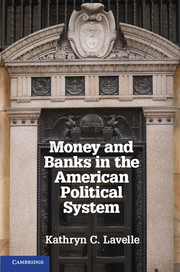Book contents
- Frontmatter
- Contents
- Figures and Tables
- Preface
- Acknowledgments
- Abbreviations
- 1 The Institutional Foundations of Financial Politics in the United States
- Section 1 A Historical Background
- Section 2 Bureaucratic Politics and Finance
- 4 Making Financial Policy in Congress
- 5 Making Financial Policy in the Executive Branch and the Federal Bureaucracy
- 6 Making Financial Policy in the Federal Reserve System
- Section 3 The Operation of the Financial Political Economy
- Section 4 Conclusions
- Glossary
- References
- Index
- References
6 - Making Financial Policy in the Federal Reserve System
Published online by Cambridge University Press: 05 January 2013
- Frontmatter
- Contents
- Figures and Tables
- Preface
- Acknowledgments
- Abbreviations
- 1 The Institutional Foundations of Financial Politics in the United States
- Section 1 A Historical Background
- Section 2 Bureaucratic Politics and Finance
- 4 Making Financial Policy in Congress
- 5 Making Financial Policy in the Executive Branch and the Federal Bureaucracy
- 6 Making Financial Policy in the Federal Reserve System
- Section 3 The Operation of the Financial Political Economy
- Section 4 Conclusions
- Glossary
- References
- Index
- References
Summary
As the political institution that serves as a central bank in the American system, the Federal Reserve is, in its essence, a bank. The Treasury pays the government's bills. A bureau of the Treasury, the Internal Revenue Service, collects taxes. The president and Congress control who the Treasury pays and taxes – and how much – when they negotiate the annual budget. But the Treasury's general account is at the Federal Reserve. At this time in American history, the notes of that bank are the legal tender for the country and, incidentally, most global financial transactions. Although it is not a branch of the government laid out in the Constitution, the Federal Reserve System plays a major role in financial politics because it determines monetary and some regulatory policy. It has been constructed over time through the political process, so it does not have the same structure as a commercial bank. Moreover, it handles many additional tasks that can seem to contradict each other outright. These contradictions result from the political compromises necessary to bring it into existence only a century ago.
In brief, the Federal Reserve System is structured with a central Board of Governors in Washington, DC, and Reserve Banks in each of twelve districts whose stock is owned by commercial banks that have chosen to join the system (i.e., member banks). Policy results from a mix of the activities between the board and the Reserve Banks. Monetary policy is made in the Federal Open Market Committee (FOMC), a committee comprising the seven board members in Washington appointed by the president, the head of the most significant regional Reserve Bank, the Federal Reserve Bank of New York (FRBNY), and four additional members that rotate among the heads of the remaining eleven Reserve Banks. Regulatory policy is issued through the board. The regulations issued can apply to the entire banking system or just to member banks, depending on their nature. The Reserve Banks operate a nationwide payment system and supervise and regulate member banks and bank holding companies. As a part of these activities, they distribute coin and currency throughout the country.
- Type
- Chapter
- Information
- Money and Banks in the American Political System , pp. 135 - 162Publisher: Cambridge University PressPrint publication year: 2013



